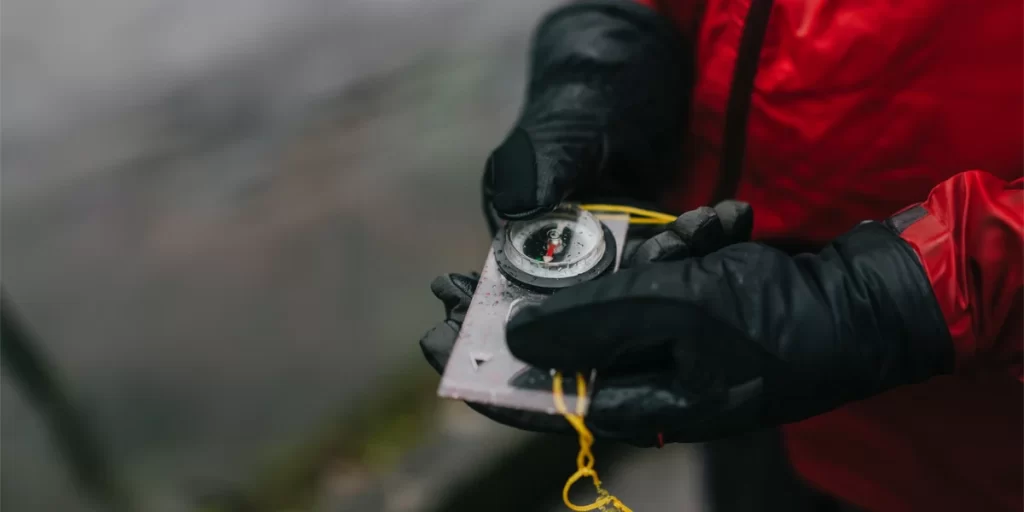

When you’re preparing for a hike, don’t overlook the importance of your hiking gloves. They’re your pals on the trail, keeping your hands comfy and safe.
In this post, we’ll explore the world of hiking gloves and help you choose the perfect pair. Ready? Let’s go.
Let’s clear things up from the start—this post is all about hiking gloves, not mittens. The key difference? Gloves have separate compartments for each finger, while mittens don’t. Mittens can be warmer, but gloves give you more control.
Before we jump into picking the perfect hiking gloves, let’s first get to know the different types you’ll come across. There are four main kinds, each providing protection and comfort for different terrains and weather conditions:
Full-fingered hiking gloves are versatile and widely used, offering complete hand protection against the elements, abrasions, and trail hazards—making them the most common type.
Synthetic Full-Fingered Gloves:

Synthetic full-fingered gloves are favored by hikers for their lightweight, breathable design. Made from materials like polyester, nylon, or spandex, and featuring durable coatings like nitrile or polyurethane for improved grip and protection, these gloves shine in mild to moderate weather conditions for most. They are also relatively affordable.
Leather Full-Fingered Gloves:

Leather full-fingered gloves, valued for their toughness, excel in shielding against abrasions, sharp terrain, and thorns. While less breathable than synthetic gloves, they are ideal for colder weather, providing superior insulation. These gloves are a top choice for hikers prioritizing warmth and ruggedness. Keep in mind, they can be quite expensive, making them a niche product.

Fingerless gloves, preferred by those who require finger dexterity, keep fingertips exposed for tasks like adjusting cameras or occasional rock climbing. Usually made from synthetic materials, they strike a balance between protection and usability. In our view, they’re a specialized piece of gear—you’ll know if you need a pair.

Liner gloves are thin, lightweight layers designed to go beneath your main hiking gloves or be worn as a separate pair in fair weather. They provide insulation in the cold and wick away moisture in warmer weather. Made from materials like merino wool, fleece, or synthetics, they are affordable and versatile. We really appreciate them as they make handling trekking poles much more comfortable.

Winter gloves are specialized gloves designed for extreme cold and wet conditions. They extend past the wrist onto the forearm, effectively blocking snow and moisture in harsh alpine settings. Heavily insulated and often waterproof, they’re perfect for mountaineering, winter, and high-altitude treks. There are plenty of designs available, including ones with removable liners.
TIP: If you are searching for them online, you can also use the term “Alpine Gauntlets” to find expedition-specific models.

Choosing the right hiking gloves requires careful thought, mainly depending on the weather you’ll encounter. For summer hikes, we prefer liner gloves. In spring and autumn, synthetic full-fingered gloves are our go-to, and for winter outings, we opt for winter gloves.
Regardless of the type you choose, consider these key factors before making your decision:
Prioritize features based on your hiking conditions and activities. Remember, warmer gloves are always bulkier, highlighting the importance of selecting gloves that match your needs.
Look out for some optional comfort features that can enhance your use case, including:
In summary, hiking gloves are essential gear for outdoor enthusiasts, providing protection and comfort in various terrains and conditions.
Understanding glove types, key factors, and optional comfort features is crucial for making the best choice. If you’re not sure where to find them, we suggest checking out REI, where you can find the best options for both men and women.
With this knowledge, you’re prepared to choose the perfect pair for your next hike. Happy trails!
Exploring the top clothing choices for your ultralight adventure? Find the lightest options for both men and women.
Yes, wearing gloves while hiking is a smart choice. Hiking gloves offer protection from elements, abrasions, and terrain hazards while keeping your hands comfortable. They provide a better grip on trekking poles, aid in tasks like using GPS or smartphones, and are crucial for colder weather. So, whether you’re trekking through moderate conditions or braving extreme cold, investing in the right hiking gloves is a must for any outdoor enthusiast.
The best gloves for hiking depend on various factors such as the weather, terrain, and your specific needs. Full-fingered gloves are versatile and offer all-around protection. Synthetic gloves made of materials like polyester or nylon are great for moderate conditions, while leather gloves excel in rugged terrains and colder weather. Fingerless gloves provide dexterity for tasks like using gadgets. Liner gloves offer added insulation, and winter (ski) gloves are ideal for extreme cold and wet conditions. Choose gloves that align with your hiking conditions and preferences to ensure comfort and protection on the trail.